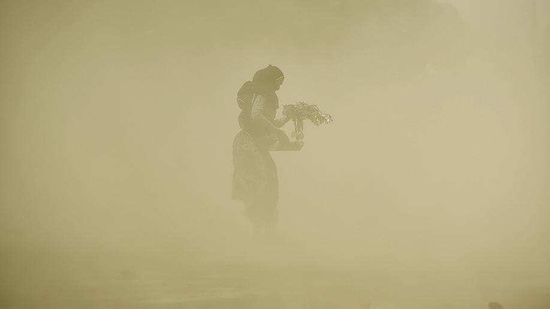Dusty winds add to pollution, mercury may rise from Apr 2
The average air quality index on Tuesday was recorded at 232, in the “poor” category.
Dry, dust laden winds from Rajasthan have started blowing over Delhi leading to a deterioration in air quality and visibility in the Capital.

The average air quality index on Tuesday was recorded at 232, in the “poor” category. The concentrations of PM 10 (coarse pollution particles) spiked from 224 micrograms per cubic metres to 326 micrograms per cubic metres at 4pm, according to data with the Central Pollution Control Board.
The PM 10 concentration at 9pm was 361.1 micrograms per cubic metres. The 24-hour safe standard for PM10 as per CPCB is 100 micrograms per cubic metres.

Scientists from the India Meteorological Department said the air quality is likely to deteriorate further as strong, westerly winds is likely to blow over the city till April 1.
“The change in the colour of the sky is mainly due to dust. There is loose soil floating around and strong winds is raising this soil and dust particles. Westerly winds, which is blowing at about 40kmph, is also bringing dust from Rajasthan. These conditions will continue till April 1, following which temperature will rise further,” said Kuldeep Shrivastava, head, regional weather forecasting centre.
The relative humidity was only 16% to 17% on Tuesday afternoon.
According to IMD scientists, dust raising winds are affecting the entire Indo-Gangetic Plains region.
“Our models are showing that these strong winds will prevail for 2-3 days. There is no moisture incursion over the region. Winds are blowing from dry regions to the west and northwest. Heat wave conditions were recorded over parts of Uttar Pradesh, Rajasthan, Gujarat, Madhya Pradesh and Delhi on Monday because of clear skies, uninterrupted solar radiation and low wind speed. But the strong winds will help keep the maximum temperature in check for now. Maximum temperatures will shoot up again from April 2 or April 3,” said K Sathi Devi, head, national weather forecasting centre.
A severe heat wave condition affected Delhi on Monday, as the maximum temperature shot up to 40.1 degrees Celsius — at least eight degrees above normal and the highest March temperature since March 31, 1945 .
The maximum temperature recorded at Safdarjung observatory — which is taken as the official marker for Delhi’s weather — on Tuesday was 37.9 degrees Celsius, six degrees above normal.
The minimum temperature was recorded at 19 degrees Celsius, one degree above normal.
For the plains, a heatwave is declared when the maximum temperature is more than 40 degrees Celsius, and at least 4.5 notches above normal.
A severe heatwave is declared if departure from normal temperature is more than 6.5 degrees Celsius, according to the IMD.
In Delhi, the normal maximum temperature for March-end is 30-32 degrees Celsius.
Heat wave can also be declared when the actual maximum temperature remains 45 degrees Celsius or more for a day irrespective of normal maximum temperature, officials said.
Stay updated with all top Cities including, Bengaluru, Delhi, Mumbai and more across India. Stay informed on the latest happenings in World News along with Delhi Election 2025 and Delhi Election Result 2025 Live, New Delhi Election Result Live, Kalkaji Election Result Live at Hindustan Times.
Stay updated with all top Cities including, Bengaluru, Delhi, Mumbai and more across India. Stay informed on the latest happenings in World News along with Delhi Election 2025 and Delhi Election Result 2025 Live, New Delhi Election Result Live, Kalkaji Election Result Live at Hindustan Times.






